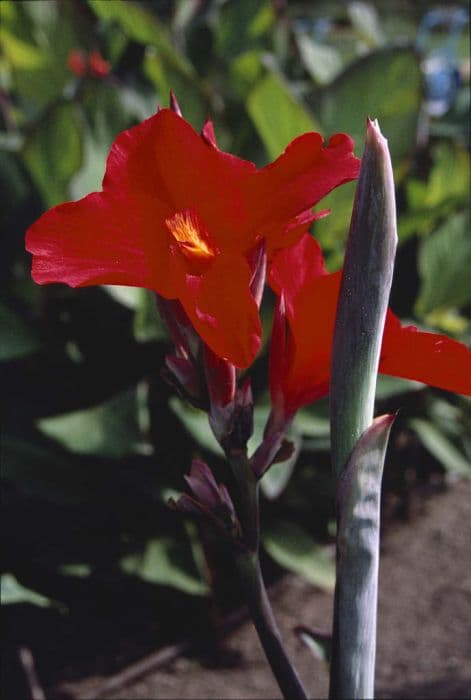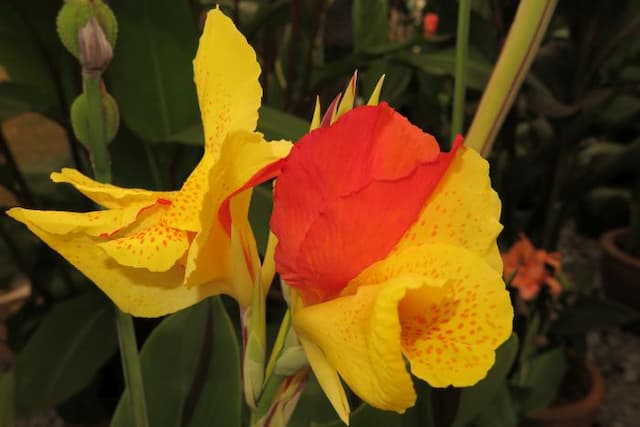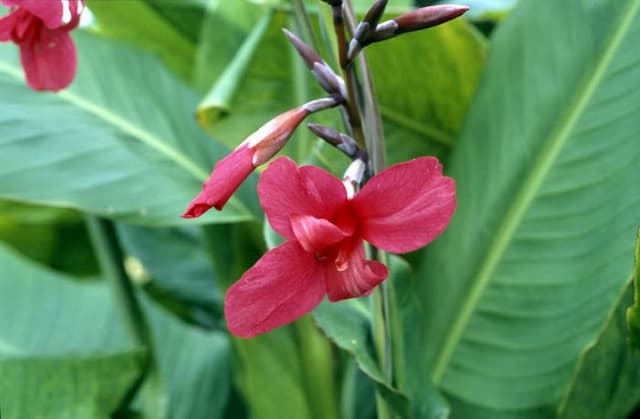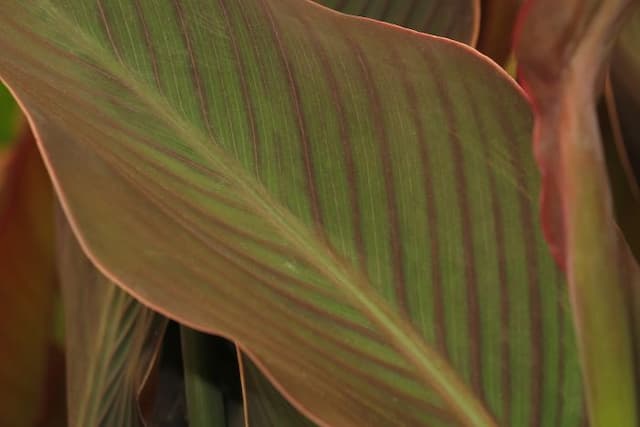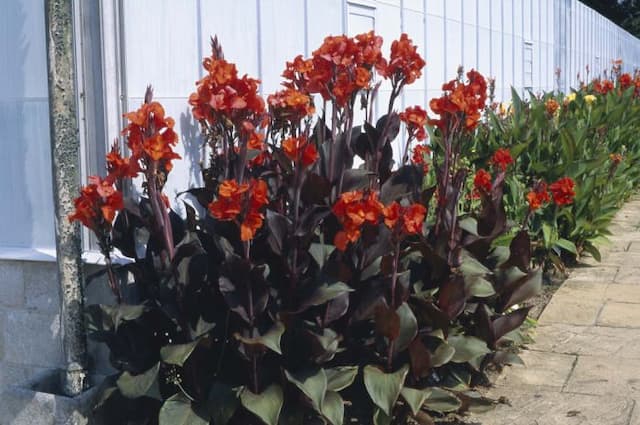Canna 'Lenape' Canna 'Lenape'

ABOUT
'Lenape' a compact plant with pale-edged green leaves and light yellow flowers heavily freckled with reddish-orange, opening from mid summer to early autumn
About this plant
 Names
NamesFamily
Cannaceae.
Synonyms
Indian Shot, Canna Lily, Canna.
Common names
Canna 'Lenape'.
 Characteristics
CharacteristicsLife cycle
Perennials
Foliage type
Deciduous
Color of leaves
Green
Flower color
Red
Height
3-4 feet (0.9-1.2 meters)
Spread
1.5-2 feet (0.45-0.6 meters)
Plant type
Bulb
Hardiness zones
7
Native area
Americas
Benefits
 General Benefits
General Benefits- Ornamental Value: The Canna 'Lenape' adds aesthetic appeal to gardens and landscapes with its vibrant flowers and attractive foliage.
- Low Maintenance: It is relatively easy to care for, requiring minimal maintenance once established in the appropriate environment.
- Attracts Pollinators: Its flowers attract pollinators such as bees, butterflies, and hummingbirds, which are beneficial for the ecosystem.
- Heat Tolerance: This plant is tolerant of high temperatures, making it suitable for warm climate gardens.
- Drought Resistance: Canna 'Lenape' has good resistance to short periods of drought once established.
- Soil Adaptability: It can adapt to a range of soil types, though it prefers rich, moist soils.
- Fast Growth: This canna cultivar grows relatively quickly, providing swift gratification in garden spaces.
- Versatility: The plant can be used in a variety of garden styles, including containers, borders, and as a focal point.
 Medical Properties
Medical PropertiesThis plant is not used for medical purposes.
 Air-purifying Qualities
Air-purifying QualitiesThis plant is not specifically known for air purifying qualities.
 Other Uses
Other Uses- Bioplastic production: The starch-rich rhizomes of the Canna can be processed to produce biodegradable plastics.
- As a bioindicator: Canna plants can be used to detect the presence of certain heavy metals in the soil, as they may show signs of stress or discoloration when exposed to pollutants.
- Animal fodder: In some regions, the foliage of the Canna is used as food for livestock, particularly in times of scarcity.
- Ethanol production: The high starch content in the rhizomes can be fermented to produce ethanol, a sustainable biofuel.
- Ink production: The vibrant pigments found in Canna flowers have been used traditionally to make natural inks and dyes.
- Thatching and weaving: In certain cultures, the leaves of the Canna plant are utilized for thatching roofs and weaving mats or baskets.
- Candle making: The waxy coating on Canna leaves has been used in some regions to create candles or to provide a waterproof layer for various craft items.
- Paper making: The fibrous content of Canna leaves lends itself to the production of specialty paper or handmade paper products.
- Water filtration: Canna plants grown in constructed wetlands can help filter and clean wastewater due to their high nutrient uptake from the water.
- Fish poison: Historically, some indigenous tribes used parts of the Canna plant to stupefy fish, making them easier to catch.
Interesting Facts
 Feng Shui
Feng ShuiThe Canna is not used in Feng Shui practice.
 Zodiac Sign Compitability
Zodiac Sign CompitabilityThe Canna is not used in astrology practice.
 Plant Symbolism
Plant Symbolism- Exotic beauty: Cannas are often associated with exotic beauty due to their vibrant flowers and tropical origin, which make them stand out in any garden.
- Confidence: The bold and bright appearance of the Canna flower can symbolize confidence and pride, reflecting the plant's majestic presence.
- Vibrancy: With its luminous colors and large leaves, the Canna represents vibrancy and a zest for life.
- Change: The Canna's cycle of blooming and fading can be symbolic of transformation and change, as it dies back in winter and returns in spring.
- Innovation: The Canna has been bred into numerous cultivars, like the 'Lenape', symbolizing human ingenuity and the spirit of innovation.
 Water
WaterThe Tropicanna Canna should be watered deeply and thoroughly to ensure the soil is moist, especially during the growing season. As a rule of thumb, water the plant once a week, but you may need to adjust the frequency based on weather conditions—more often in extreme heat or less if it’s rainy. Each watering session should involve about 1-2 gallons of water, depending on the size of your canna and the soil's ability to retain moisture. Make sure that the water penetrates the soil to reach the roots and that the plant is not sitting in water, as this can lead to root rot.
 Light
LightTropicanna Cannas thrive best in full sun conditions, where they can receive at least 6 to 8 hours of direct sunlight daily. The ideal spot for these plants would be in a location that gets uninterrupted sunlight throughout the day, although they can tolerate partial shade, their flowering might be reduced.
 Temperature
TemperatureTropicanna Cannas prefer warm temperatures and are typically grown in USDA hardiness zones 7 through 10. They can tolerate temperatures as low as 55 degrees Fahrenheit, but the ideal temperature range for these plants is between 70 and 90 degrees Fahrenheit. Cannas should be protected from frost, as temperatures below 55 degrees can be harmful to the plant.
 Pruning
PruningPruning Tropicanna Cannas involves removing dead or yellowing leaves to encourage healthy growth and improve air circulation. Prune as needed throughout the growing season, cutting back foliage and spent flower stalks to the base. The best time to do a major pruning is in late winter or early spring before new growth begins.
 Cleaning
CleaningAs needed
 Soil
SoilCanna 'Lenape', also known as Indian Shot or Canna Lily, thrives best in a rich, moisture-retentive soil mix with good drainage. A mixture of garden soil, compost, and perlite or sand is ideal. The desired pH range for Canna Lilies is between 6.0 and 6.5.
 Repotting
RepottingCanna Lilies, including the 'Lenape' variety, should generally be repotted every two to three years, or when the rhizomes outgrow their current container. It's best to repot them in the spring as new growth begins.
 Humidity & Misting
Humidity & MistingCanna Lilies prefer high humidity levels; however, they are quite adaptable and can tolerate the lower humidity levels typically found in outdoor garden environments.
 Suitable locations
Suitable locationsIndoor
Place in bright, indirect light, and ensure high humidity and warmth.
Outdoor
Plant in full sun, fertile soil, and keep well-watered.
Hardiness zone
8-11 USDA
 Life cycle
Life cycleThe Canna 'Lenape', commonly known as Indian Shot or Canna Lily, begins its life as a rhizome which sprouts in spring when the soil warms up. The shoots emerge from the rhizomes, developing into large, paddle-shaped leaves and a sturdy stem that can reach up to a few feet in height, depending on the variety. During the summer, the Canna 'Lenape' produces large and colorful flowers that can be in shades of red, orange, or yellow, which are pollinated by insects. After flowering, the plant can produce seed pods containing round black seeds that resemble shotgun pellets, hence the name Indian Shot. As the growing season ends and temperatures drop in autumn, the above ground parts of the plant will die back, and the plant will go dormant over winter. The rhizomes persist underground throughout the dormant period and can be divided and replanted to propagate new plants for the next growing season.
 Propogation
PropogationPropogation time
Spring-Early Summer
The Canna 'Lenape', commonly known as the Canna Lily, is typically propagated through division, which is its most popular method of propagation. Propagation is best carried out in the spring, just before the growing season begins, when the plant is coming out of dormancy and has the most energy for producing new growth. To propagate by division, the gardener should carefully lift the rhizomes from the ground after the foliage has died back or just before new growth starts. Using a sharp knife, the rhizomes are divided into sections, ensuring that each section has at least one eye or bud. These sections are then planted about 3 to 4 inches (7.6 to 10.2 cm) deep in soil, spaced about 1 to 2 feet (30.5 to 61 cm) apart, so that they have room to grow. The soil should be well-draining but able to retain some moisture, as Canna Lily prefers these conditions. After planting, the divisions should be watered generously to help establish them.

